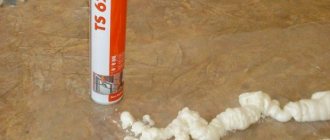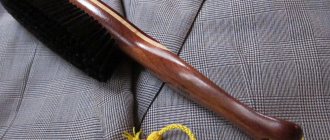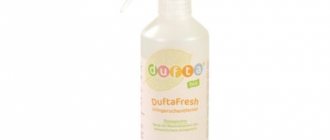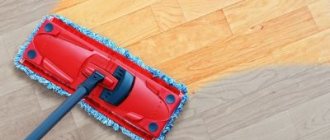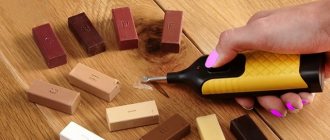Polyurethane foam is a good sealant and is widely used in construction and repair work. Has many advantages. The only drawback is that it adheres very quickly, literally in a second, to any surface, and this makes removal difficult. During work, the sealant often gets on the body, tools, clothing, wall, but most often on the floor. It is not very easy to wash foam from laminate flooring, but there are ways that can help clean the surface. There are several good ways to do the cleaning without damaging the finish.
Removing fresh composition
In order to remove the polyurethane foam from the laminate, you can use a wooden or plastic spatula. The foam must be rolled from the edge to the center, preventing the material from spreading.
It is recommended to avoid using metal tools, as their use has a high probability of damaging the delicate coating.
Polyurethane foam cleans well when using good quality cleaning products. The workplace must be treated with a substance with a high fat content. This category usually includes:
- wax;
- cream;
- oils
- polishes.
It is important to take into account that it is impossible to completely solve the problem, which can be used to wash polyurethane foam from laminate flooring. The material has excellent surface penetration properties at the molecular level, which explains the difficulty of removal.
It is better not to use this tool to remove construction foam from laminate flooring.
Features of polyurethane foam
When carrying out major renovations in an apartment, sometimes it is impossible to do without some special tools. One of them is ordinary polyurethane foam. It is so multifunctional and easy to use that one can only wonder how they coped with repairs without it before.
Rules for working with polyurethane foam
Everyone is familiar with polyurethane foam, even those who have never used it in practice. It can protrude from the cracks of houses, is used when installing plastic windows, and is often visible from under the inner lining of garages. In appearance, the frozen yellowish material is very reminiscent of foam plastic. It is quite durable, has a large number of pores, and does not sink in water.
Application of polyurethane foam
From the point of view of chemistry and construction, polyurethane foam is a polyurethane foam sealant packaged in a container, reminiscent of the packaging of a regular air freshener or a can of spray paint. Inside the cylinder there is directly a liquid prepolymer and a gas that displaces it from the container. When the foam comes out of the can, it polymerizes fairly quickly into rigid polyurethane foam.
Polyurethane foam is a polyurethane foam sealant
The material is widely popular due to its properties:
- perfectly insulates treated surfaces;
- easy to use - just purchase a cylinder and a special gun for the job;
- hardens quickly;
- saves work time;
- not afraid of moisture;
- does not conduct electricity;
- has excellent adhesion to any surface;
- penetrates well even into small cracks and gaps;
- can be used in professional construction and for minor installation work.
Polyurethane foam - a necessary sealant in construction
On a note! Previously, tow and cement were used instead of foam, which in comparison are quite difficult to work with. The cement required preparation and took a long time to dry, which resulted in long installation times.
Polyurethane foam is ideal for sealing all kinds of joints and seams, moreover, between almost any materials. It is also used for assembling a wide variety of structures made of plastic, wood, and metal. Foam does not work only with the following types of coatings - Teflon, polyethylene, silicone. In general, the options for using polyurethane foam can be very different; it is enough to know how to use it - the final result will depend on following the technology for working with it.
Foam gun
Aspects of using polyurethane foam:
- work is carried out only at air temperatures from +5 to +30 degrees;
- working with the material requires gloves;
- the optimal width of the cracks for sealing should be in the range from 1 to 8 cm;
- Before work, the gaps are treated with water - the humidity of the treated surface should be 60-80%. This will affect the quality and speed of polymerization;
- Before starting work, shake the container well;
- The time for complete hardening of the foam is about 8 hours.
Polyurethane foam hardens in approximately 8 hours
On a note! Foam does not like exposure to ultraviolet radiation, so it is better to hide it from sunlight with a layer of putty, plaster or casing.
Due to all the properties described above, foam is quite difficult to remove from various surfaces. Therefore, you need to be careful when working with it.
Polyurethane foams "TechnoNIKOL"
Prices for polyurethane foam "Macroflex"
macroflex polyurethane foam
Available means
You can clean the laminate from polyurethane foam using regular wallpaper glue or PVA, to which you should add a small amount of salt. It is recommended to cut off the main part of the sealant, and place a rag generously soaked in the solution on top of the remaining part. After some time, the foam will become limp and can be removed from the floor covering using a damp sponge.
Important! Methods using liquids to remove polyurethane foam must be used carefully.
Laminate is a delicate type of coating that does not respond well to prolonged exposure to moisture. Due to this feature, you can soak the surface for no more than 5 minutes, as otherwise swelling and bumps may appear.
When to delete?
There are different opinions about in what condition it is better to remove it - immediately or already dried. Everything, of course, depends on the material, but it is better to do this while it is wet, since adhesion is very high. By allowing the mixture to dry out, you create additional problems for yourself.
Important! Regardless of who will do the work, you should take care not only to cover all surfaces, but also to buy equipment and preparations for removing stains.
Cleaning dried foam
Removing dried foam from laminate flooring is considered a more time-consuming and difficult task. Several effective methods can be used to clean the surface of the composition. These include the use of the following:
- special solvent;
- gasoline with stain remover;
- vegetable oil.
You can remove dried foam using a solvent. To do this, you need to choose special tools. They must contain components that provide a softening effect. First, you need to cut off as much of the sealant as possible under the base, and then place a rag soaked in liquid on top.
After soaking, the layer can be easily wiped off, and to simplify the process, it is recommended to use a hard sponge.
We remove foam that has already dried
Hardened foam is much more difficult to deal with than fresh foam. The main thing you will need is patience. One procedure may not give a positive result, so it will have to be repeated several times until the contamination goes away.
The foam that has already set on glass, metal, stone or tile is cut off with a construction knife or blade. Do this as close to the surface as possible, but with extreme caution so as not to leave scratches or injure your hands. The remaining layer of polyurethane foam is softened with a solvent and removed with a hard sponge. You can take a kitchen sponge or a metal mesh. As for solvents, it is better to use OUDAL PU Remove; the product is specially designed for removing dried fixative.
You can also try scraping off the foam mechanically. To do this, take a piece of plastic or other material that is harder than foam, but softer than the surface on which it is located. The method is suitable for enamel-coated batteries and powder-coated metal doors.
Vegetable oil has proven itself well in the fight against dried foam. First, the substance is removed under the base. Then take a soft sponge, soak it in sunflower oil and apply it to the stains for 15 minutes. Then the washcloth is turned over and the foam is removed with the rough side. After cleaning, greasy marks are washed with soapy water or dishwashing liquid.
Important points
Solvents and stain removers are aggressive compounds, so before removing the foam from the laminate, it is recommended to test it. To do this, the selected product is applied to a small area, after which the result is evaluated.
The composition can only be used if the color and appearance of the floor covering have not changed.
It is important to consider that the solvent cannot be used on all types of coatings. Such compositions are prohibited from being used on painted and varnished areas, since the product, together with the remnants of the mounting foam, will also remove the main layer of decorative material. In such a situation, there is a high risk of getting streaks and stains of various shades.
Exposure to cold is considered an effective way to remove polyurethane foam. After freezing, the composition easily comes off the surface, and to obtain the result, just carefully scrape off the sealant. Residues can be removed using a solvent or stain remover, then thoroughly wash the area with water.
How not to ruin laminate
To avoid damaging the floor covering, special cleaning products should be used. They can also clean the floor from traces of superglue and PVA. The products are sold at a hardware store. You can wipe off the foam from the laminate without damaging the surface by using only those cleaners that contain alcohol or acetone.
Before using any cleaning product, you must carefully study its composition, since not all substances can safely interact with this type of coating. Damage to the floor can be caused by products that contain ammonia, acid, alkali, or chlorine compounds.
Very often, during renovations, the floor becomes contaminated with superglue. To remove glue from laminate flooring, do the following:
- soak the adhesive stain with a solvent that does not contain aggressive substances;
- carefully remove the mark with a hard sponge;
- wash the area where the glue was with water.
Popular means
Vegetable oil is considered a safe and effective way to clean construction foam from laminate flooring. It must be applied to the work area and then left for 45 minutes. After soaking, the foam can be removed using a sponge with a hard surface.
You can remove remnants of polyurethane foam using an inexpensive product called Dimexide. The drug is used to treat diseased joints, and can be purchased at a pharmacy without a prescription. The composition has a gel consistency, which must be applied to the area with foam for 20 minutes.
Dimexide preparation for cleaning polyurethane foam from laminate flooring
Before doing this, it is recommended to cut off the main part of the sealant under the base. After the allotted time has passed, the remainder of the softened material is removed with a damp cloth.
Before washing foam from laminate flooring using aggressive and medical preparations, it is recommended to wear gloves and follow safety rules. Following these recommendations will help prevent accidents and health problems.
How to remove foam from clothes and hands?
Adhesion is extremely high, which allows it to adhere to almost any material, especially fabric. Therefore, it is almost impossible to remove such marks from clothes, however, you can try:
- Solvent of fresh or dried foam. It is necessary to treat the fabric, let it stand for 15-20 minutes, perhaps rub it. Then rinse with water or wash.
- Gasoline or white spirit and stain remover. Treat the fabric with any of the substances and wait for dissolution. Then apply stain remover and wash the item according to the instructions.
Important! There may be stains on the fabric, not from the sealant.
- Cold. To do this, you need to freeze the stains, then remove them mechanically, and then wash the clothes using a stain remover.
The basis of the “mount” is polyurethane, which does not have a critical effect on the skin, but walking around with such jewelry is not very pleasant. Therefore, if it is still damp, it can be removed with a sponge or rag soaked in gasoline, solvent or any other composition. The hardened one can only be removed mechanically or falls off on its own after a few days.
Important! After cleaning the skin, it must be treated with any cream or oil.
Rules for working with construction foam
You won’t have to worry about how to deal with the sealant if you follow several rules during the repair process, namely:
- Use safety glasses and gloves.
- Wear clothes that you won’t mind throwing away after the renovation is completed.
- Use a headdress. It must be remembered that the sealant can only be removed from the hair together with the strands.
- Use disposable material to protect furniture, walls and other surfaces. For example, cover floors and furniture with plastic film or cardboard.
- Purchase a special product along with the mounting foam that will make it easy to deal with contamination.
- Carry out construction work with an assistant. He will place the cardboard under the flowing foam in time, cover the surface with film, etc.
How to clean a gun?
There are cylinders that are used with a mounting gun. The tool simplifies the process of foaming hard-to-reach places and areas at height. A special solvent is sold for cleaning the gun. The container is installed on the instrument instead of a foam container. When squeezed out, the escaping solvent flushes the gun channels.
If the instrument is not washed in time, the polyurethane foam inside will harden. The gun is disassembled into its component parts, all holes are cleaned with wire, and solvent is poured in. After washing, the instrument is assembled in the reverse order.
How to remove a fresh one?
It is not difficult to remove fresh mounting foam, since it has not yet had time to firmly adhere to the surface. The main thing is to take action as quickly as possible. This rule applies to any materials. First aid items:
Nail polish remover .
Its effect is due to the presence of a small amount of acetone in the composition. Acting as a solvent, it breaks down the molecules of polyurethane foam, making it easy to remove.- Spatula and clean paper towel . Foam that gets onto a hard surface is removed with a construction spatula, and its remains are removed with a dry cloth.
- Vegetable oil . They moisten a cotton pad or a small rag with it and wipe the problem area. Once the stain is removed, the surface can be washed with clean warm water.
- Vinegar. To clean the product, use essence. Soak a rag in it and wipe the stain until it disappears completely.
What can't be done and why?
When removing sealant from various surfaces, the following recommendations must not be violated:
- The foam should not be spread over the surface. The material is removed with sharp movements.
- Do not try to wash off fresh foam with water. It only enhances the adhesion of the sealant to the surface.
- Painted products should not be treated with acetone or substances based on strong solvents.
- Do not clean stains with sharp objects that can scratch the product.
- It is not advisable to use metal brushes and scrapers that can scratch the surface.

